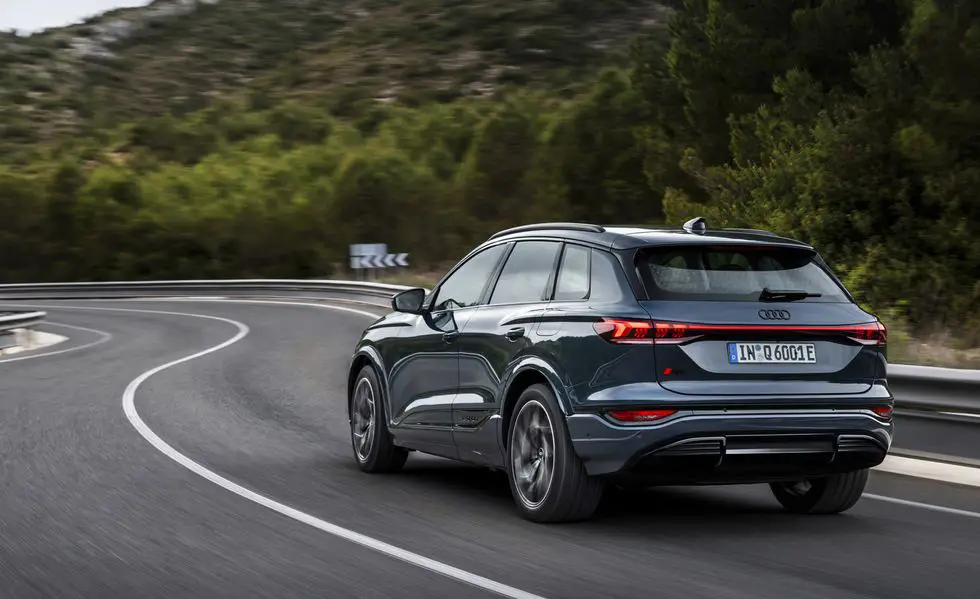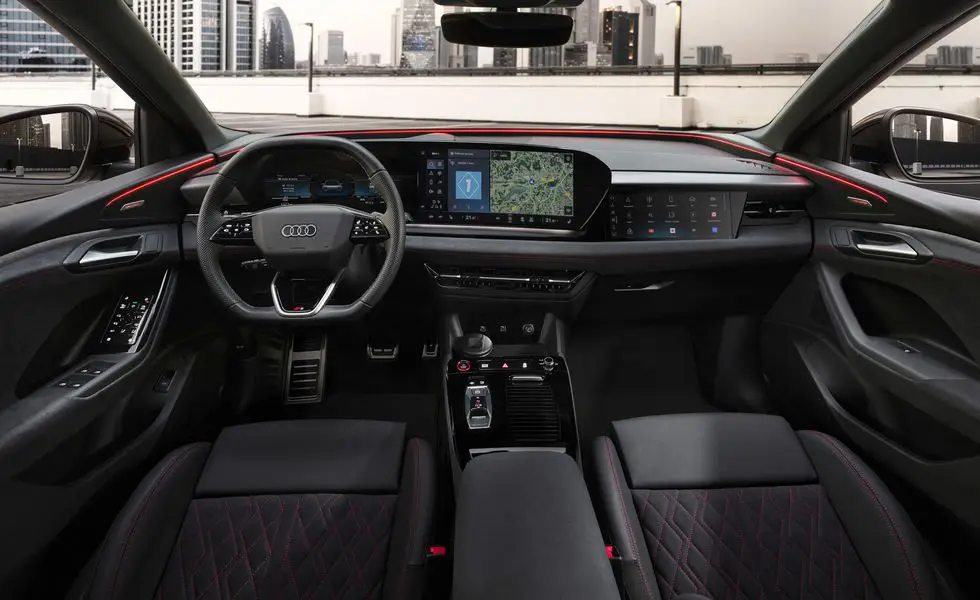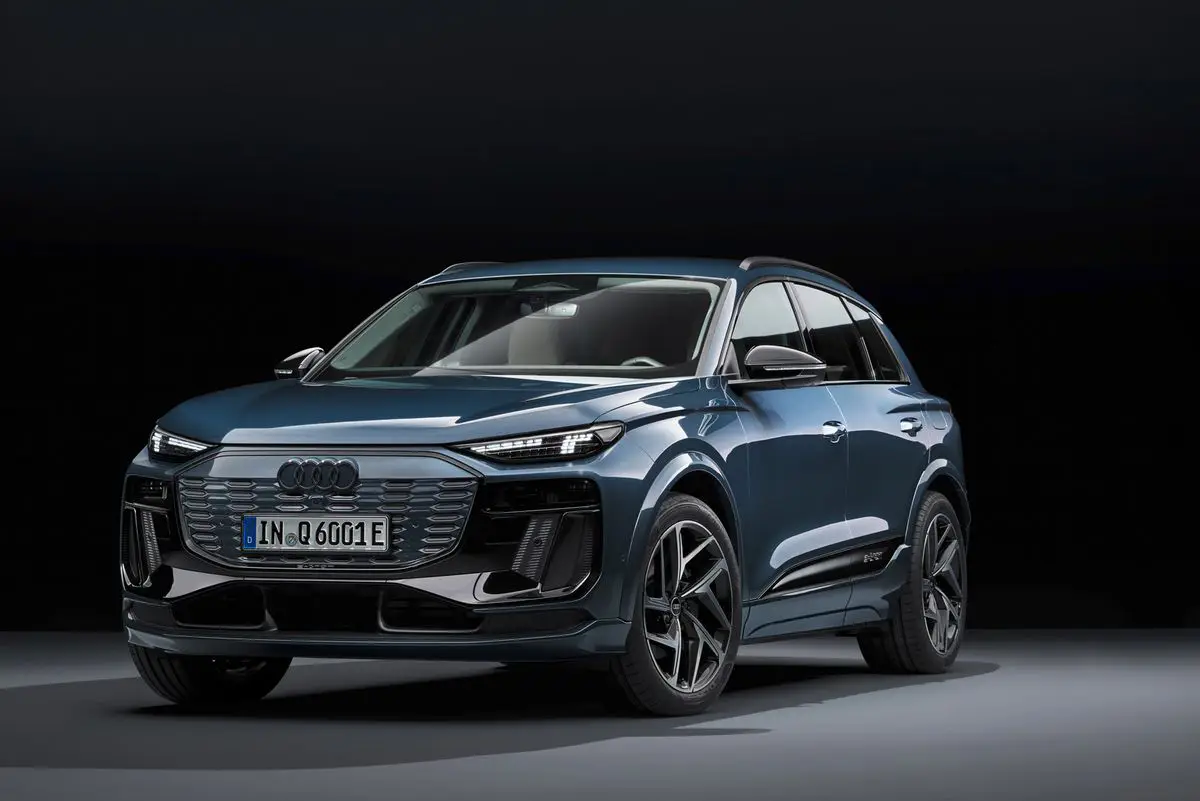2025 Audi Q6: Audi’s new electric SUVs, which aim to capture the core of the premium market, introduce new technology for the company.

- The 2025 Audi Q6 e-tron, an electric vehicle proportioned similarly to the company’s best-selling Q5 SUV, will go on sale at the end of this year.
- Initially, only two-motor all-wheel-drive variants with up to 456 and 510 horsepower will be available for the 2025 Audi SQ6 e-tron and 2025 Audi Q6.
- With its 94.4-kWh battery and innovative 800-volt electrical architecture, Audi claims the Q6 e-tron will have an EPA range estimate of at least 300 miles.
The third series of Audi electric SUVs, the 2025 Audi Q6 and SQ6 e-tron models, have finally been unveiled. These cars are several firsts for the manufacturer: they are the first EVs built at Audi’s Ingolstadt plant in Germany, the first Audi models built on the scalable Premium Platform Electric (PPE) platform of the Volkswagen Group, and the first examples of the brand’s new electrical architecture and cockpit layout. Their target market is the center of the electric luxury SUV market, where they plan to compete with vehicles like the Lexus RZ, Cadillac Lyriq, and Genesis Electrified GV70 by showcasing their latest technology inside and out.
The major announcement is the unveiling of the final external design of the 2025 Audi Q6 and SQ6, which is vintage Audi—refined, athletic, and conventionally appealing. We’ve previously seen images of the interior of the new e-tron and driven prototypes covered in camouflage. These automobiles have two-box forms with a massive grille, blistered fenders, and brilliant lighting features on both the front and rear. Later on, even more streamlined Sportback models will be added to the roster.
While You Care for Your Car, Care for Your Child’s Future Too 💖
A fun and educational book every parent should gift their kid.
 Get Kiddy Store Fortune Now
Get Kiddy Store Fortune Now

Although the brand’s most recent Matrix LED headlights and dynamic OLED taillights, which can communicate with other drivers by, for example, emitting emergency signals in response to traffic conditions, were on display in examples for the European market, federal regulations will prevent the headlights on models headed for the United States from having their dynamic high-beam function enabled, and the taillights from displaying animations unless the vehicle is parked. Having said that, there are eight different designs that drivers may choose from to personalize the daytime running lights and the taillights.
Smartly Sized
The five-passenger 2025 Audi Q6 and SQ6, measuring 187.8 inches in length, are positioned between the one-size-smaller Q4 e-tron and the one-size-up Q8 e-tron. Imagine them as electric variants of the company’s best-selling Q5, but with a wheelbase that is 3.1 inches longer (114.1 inches), which contributes to an unexpectedly roomy cabin with respectably large quantities of back legroom. With the rear seats folded, the Q6 and SQ6 have a mediocre 19 cubic feet of cargo space behind the seats, and 54 cubic feet when the rear chairs are folded. A tiny frunk can ingest two more cubes of material.
Along with a plethora of sustainable materials, the interior boasts a squared-off steering wheel and a new dash layout centered around two bright OLED displays: a 14.5-inch center touchscreen and a curved 11.9-inch digital gauge cluster. There’s also an optional 10.9-inch passenger touchscreen that can play videos but is hidden from the driver’s view when the car is moving. From our brief experience with a demonstration car, the infotainment software operating these panels is a new Android-based system that appears to be well-designed and easy to use.

Even though we usually like more firm buttons, we quickly got used to the new configuration. A new AI voice control that can pick up on a driver’s preferences and habits is also available to help. Highlights also include an 830-watt Bang & Olufsen premium audio upgrade, dynamic ambient lighting across the dashboard, augmented reality navigation on a head-up display, and over-the-wire software and feature updates support. Not only should these EVs be incredibly quiet on the road, but so should our prototype drive.
Naturally, the 2025 Audi Q6 and SQ6 will come equipped with an extensive array of driver-assistance technologies, including automated front emergency braking, cruise control, rear parking assistance, lane-departure warning, and warnings for driver distraction and tiredness. To assist these Audis with navigation, an upgraded Adaptive Driving Assistant Plus system will be available as an option.
Advanced Architecture
The 2025 Audi Q6 and SQ6 e-trons will first be launched with two motors and all-wheel drive, but an entry-level variant with a single-motor rear-wheel drive will soon be available in the United States. The combined output of the 2025 Audi Q6 and SQ6 is 422 and 483 horsepower, respectively.
A Boost mode can temporarily increase those numbers to 456 and 510 horsepower. According to Audi, the new 94.4-kWh battery should provide the Q6 with the power to accelerate to 60 mph in just 5.0 seconds and enough energy to give it an EPA range estimate of at least 300 miles. The more potent SQ6 is said to reach 60 mph in 4.2 seconds, though it probably won’t go as far on a charge.

Fast charging at up to a powerful 270 kW is possible with the 800-volt PPE architecture, which is also the foundation of the new Porsche Macan EV—that is, if you can locate a station that can provide that much power. According to Audi, under ideal circumstances, the technology can add more than 150 miles of range in 10 minutes. Recharging from 10 to 80 percent should take about 21 minutes. The PPE software facilitates bank charging at stations with 400-volt limitations. In this method, the battery is split in half by the computer of the system, and both halves are charged in parallel at a maximum power of 135 kW.
The 2025 Audi Q6 and SQ6 will initially ship with the more widely used Combined Charging System (CCS) connector, but Audi claims that they will soon switch to a North American Charging Standard (NACS) socket for simple interoperability with Tesla’s Supercharger network. The usual onboard AC charger for recharging the battery at home is 9.6 kW; a 19.2 more powerful kW unit will be available as an option later. Regenerative braking can be operated in five different ways while driving, including an automatic mode and one-pedal operation, using the paddles on the steering wheel.
Mechanically speaking, the 2025 Audi Q6 and SQ6 are different from the Macan EV in that the former use permanent-magnet motors in both the front and rear, while the latter use an induction AC motor up front and a permanent-magnet synchronous AC motor in the rear. The Porsche also features a repositioned rear motor unit, which ought to enhance the rear drive’s handling balance.
Although the SQ6 will come standard with air springs and adjustable dampers, these will be optional on the 2025 Audi Q6. Audi’s all-wheel-drive system is still rear-biased. The SQ6 comes standard with 20-inch wheels and an optional summer tire. The range of wheel diameters is 19 to 21 inches. Both models will be rated to tow up to 4400 pounds for individuals who intend to pull moderate weights.
The price for the US market is still unknown. The SQ6 e-tron is anticipated to launch for roughly $72K, while the Q6 e-tron is anticipated to start at around $66,000. Compared to the Q5 and SQ5, which presently have starting prices of $46,495 and $58,895, respectively, that is a good deal more. However, in a fiercely competitive SUV market, their additional features and fast charging capacity should make them attractive EV choices.

